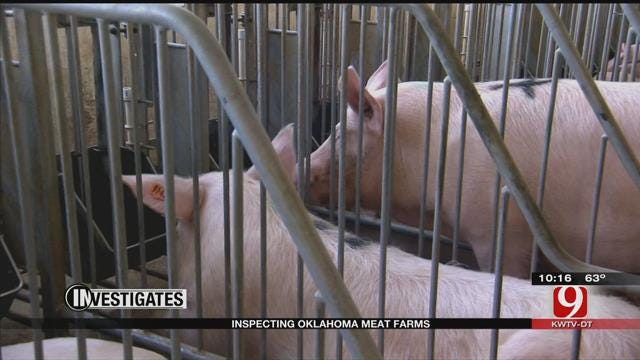9 Investigates: Inspecting Oklahoma Meat Farms
<p>Agriculture may not play the role it once did in the Oklahoma economy, but in rural northwest Oklahoma, it still matters. </p>Thursday, April 21st 2016, 10:54 pm
Agriculture may not play the role it once did in the Oklahoma economy, but in rural northwest Oklahoma, it still matters. The large corporate swine and cattle operations provide valuable employment and are part of an industry that helps feed the world.
Still, there is a contingent of Oklahomans who believe these farms -- concentrated animal feeding operations, or CAFO's -- pose a public health risk because they are under-regulated.
9 Investigates decided to take a closer look at that allegation and was given a rare opportunity to visit a large commercial animal farm.
"We look for feed spills, make sure their feeds are cleaned up," said Ada Pfeiffer, one of the Department of Agriculture's five CAFO inspectors. "The pest boxes are to be covered and have bait in them."
With 9 Investigates' camera rolling, Pfeiffer walked the perimeter of the entire facility -- the barns, as well as, the lagoons -- taking notes as she walked.
"Generally," said the Department of Agriculture's Jeremy Seiger, "they're looking at on-the-ground management practices they have in place, they're doing a records review,"
Seiger is in charge of the department's Agricultural Environmental Management Services (AEMS) division. He says the goal of the inspections program is to protect the groundwater, which is why inspectors' primary focus is on how each CAFO manages its animal waste.
"The biggest problem would be if we had issues with the lagoons," Seiger noted.
Pfeiffer has been doing this for years and knows what to look for.
"We just look for any kind of damage or anything like that," Pfeiffer explained. "I'm not saying it's common -- that's just one of the things we look for."
According to Seiger, there are 262 concentrated animal feeding operations in Oklahoma. Many of them have multiple barns and lagoons, and all have strict disinfection rules to protect herd health. He says that adds to the challenge of getting each CAFO inspected annually, as the law requires.
"We have to abide by certain bio-security [rules] with those farms," Seiger said, "which means we may be able to visit one farm one day, but then...have a certain length of down time before we can go to another farm."
Two-hundred sixty two CAFOs monitored by five inspectors.
"That's simply not adequate, that's simply not sufficient," said former Oklahoma Attorney General Drew Edmondson.
Edmondson took on the poultry industry when he was attorney general, over concerns that chicken litter was fouling the water in eastern Oklahoma. He says the state should devote more resources to inspecting CAFOs, because their lagoons pose a similar contamination risk.
"If they're constructed correctly, if they're lined a correctly, they're not a problem," said Edmondson in a recent interview, "but there have been breeches, and if those holding ponds breech, then all of that waste goes out into the nearest available waterway and that does create a problem."
According to records obtained by 9 Investigates, there have been 134 reported discharges of waste at pig, cattle and dairy operations since 2010, totaling more than 670,000 gallons of waste.
But the same records indicate, in only two of those discharges did waste run off into an actual waterway. What's more, officials with the state Department of Environmental Quality say, of the 63 boil advisories DEQ has issued in the last five years, not one was linked to improper waste management at a CAFO.
Another Open Records Act request provided 9 Investigates with the last five years of inspection reports for the state's 25 largest CAFOs. A search of those documents reveals no major problems, but plenty of minor ones, which were duly noted by the state inspectors.
In fact, from 2010 to the end of 2015, CAFOs in Oklahoma were fined more than half a million dollars, in part because of the inspections.
"We welcome the inspection," said Roy Lee Lindsey, executive director of the Oklahoma Pork Council.
Lindsey was also there in Mooreland for the swine farm visit. He says it's just as much in the farm's interest to protect the environment, which is why, he says, they do their own inspections quarterly.
"We believe we're doing a good job on our own," Lindsey stated, "but it's nice to have somebody else come by, [with] a second set of eyes, if you will, to look for things that maybe we miss."
Near the end of Ada Pfeiffer's mock inspection, she said everything seemed to be in order and she'd seen nothing to cause concern -- "I have not yet."
Pfeiffer says five inspectors may seem like too few to some, but she says they get the job done, without cutting corners.
More Like This
April 21st, 2016
November 13th, 2024
October 28th, 2024
October 17th, 2024
Top Headlines
December 19th, 2024
December 19th, 2024
December 19th, 2024










